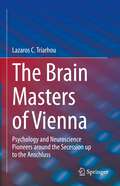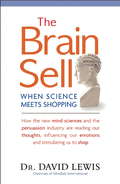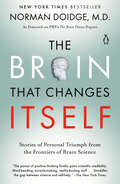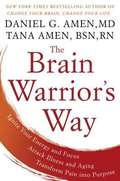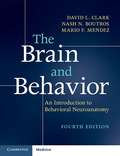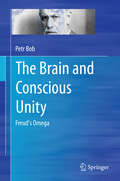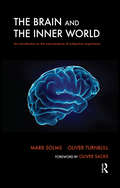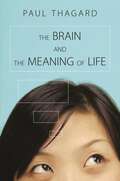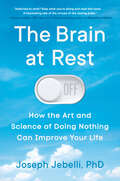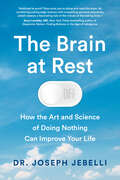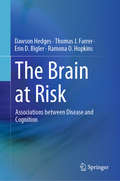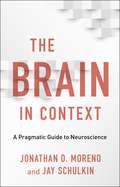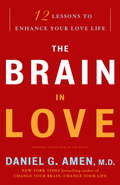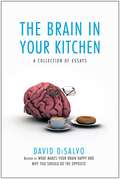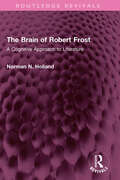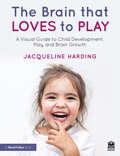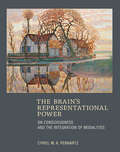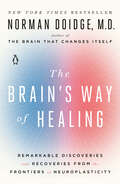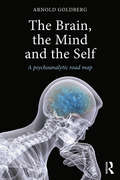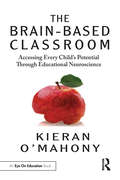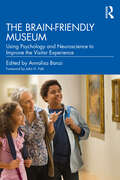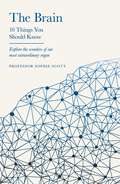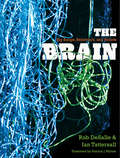- Table View
- List View
The Brain Masters of Vienna: Psychology and Neuroscience Pioneers around the Secession up to the Anschluss
by Lazaros C. TriarhouThe book comprises biographical notes, of about 1000 words each, with a portrait photo, of 90 influential figures of the famous prewar Viennese school of neuropsychiatry, appearing together for the first time in a single volume. The entries focus on the academic lives and scientific contributions of pioneers in the neurological sciences viewed from a modern perspective. These updated profiles are based on substantial new research. The book includes a wide range of people, some famous Nobel laureates, and others less well known, from the era when Vienna was the epicenter of brain research. Despite the tragic circumstances of two World Wars, these pioneers remained resilient, willing to help others with an admirable dignity against adversity that leaves an indelible lesson to the later generations. Some fell victim of the Holocaust. Others overcame the constraints of National Socialism and ultimately settled overseas to nurture their ambitions and pursue their intellectual goals as physicians, researchers, and teachers. The monograph is a useful source for scholars interested in the evolution of ideas in basic neuroscience, clinical neurology, and neuropsychiatry, and the investigators who effected them.
The Brain Sell
by David LewisIn a room sat a theoretical physicist, an engineer, a mathematician, a biochemist, and a neuropsychologist. Their task? To evaluate the effectiveness of a marketing campaign for a grooming product that retails for less than $15.00.The Brain Sell, praised as the new Hidden Persuaders, is the inside story of how our rapidly evolving understanding of the brain plays into the advertising, marketing, and retailing industry. With the emergence of Big Data mining, the "persuasion industry" is more prominent than ever. David Lewis, PhD, internationally renowned researcher, brings science to shopping-mapping the brain and the body to explore the sensitivities in our minds and discover how we select and buy. Gone are the days of traditional salesmanship-in the United Kingdom and United States alone, $313 billion is spent annually on subliminal messaging and measuring consumers' subconscious reactions to the color of a child's toy, the smell of a store's interior, or the font of the smallest letter on a soup can. Lewis repeatedly surprises with secrets from the advertising and marketing industries, revealing the scientific strategies used to evaluate and manipulate consumer response. An enlightening read for marketers and advertisers and an urgently important one for anyone who considers themselves a "smart shopper." The Brain Sell shows that even after the product is on the shelf and the commercial is over, the sales pitch goes on.David Lewis, PhD, a neuropsychologist, is founder and director at the independent research consultancy Mindlab International based at the University of Sussex. Additionally, he is a psychologist, an international lecturer, and acclaimed author, most recently of Impulse (Harvard University Press). Dubbed the "father of neuromarketing" for his pioneering studies of analyzing brain activity for research and commercial purposes, he currently specializes in noninvasive techniques for measuring human responses under real life conditions.
The Brain Sell: When Science Meets Shopping
by David LewisScience has made the leap from the lab to come to a store near you and the effects on us are phenomenal. Corporations in hyper-competition are now using the new mind sciences to analyze how and when we shop, and the hidden triggers that persuade us to consume. From bargains in the Big Apple to the bustling bazaars of Istanbul, from in-store to interactive and online to mobile, neuromarketing pioneer Dr. David Lewis goes behind the scenes of the persuasion industry to reveal the powerful tools and techniques, technologies and psychologies seeking to stimulate us all to buy more often without us consciously realizing it.
The Brain That Changes Itself: Stories of Personal Triumph from the Frontiers of Brain Science
by Norman DoidgeWhat is neuroplasticity? Is it possible to change your brain? Norman Doidge’s inspiring guide to the new brain science explains all of this and moreAn astonishing new science called neuroplasticity is overthrowing the centuries-old notion that the human brain is immutable, and proving that it is, in fact, possible to change your brain. Psychoanalyst, Norman Doidge, M.D., traveled the country to meet both the brilliant scientists championing neuroplasticity, its healing powers, and the people whose lives they’ve transformed—people whose mental limitations, brain damage or brain trauma were seen as unalterable. We see a woman born with half a brain that rewired itself to work as a whole, blind people who learn to see, learning disorders cured, IQs raised, aging brains rejuvenated, stroke patients learning to speak, children with cerebral palsy learning to move with more grace, depression and anxiety disorders successfully treated, and lifelong character traits changed. Using these marvelous stories to probe mysteries of the body, emotion, love, sex, culture, and education, Dr. Doidge has written an immensely moving, inspiring book that will permanently alter the way we look at our brains, human nature, and human potential.From the Trade Paperback edition.
The Brain Warrior's Way: Ignite Your Energy and Focus, Attack Illness and Aging, Transform Pain into Purpose
by Daniel G. Amen Tana AmenNew York Times bestselling authors Dr. Daniel Amen and Tana Amen are ready to lead you to victory... When trying to live a healthy lifestyle, every day can feel like a battle. Forces are destroying our bodies and our minds. The standard American diet we consume is making us sick; we are constantly bombarded by a fear-mongering news media; and we're hypnotized by technical gadgets that keep us from our loved ones. Even our own genes can seem like they're out to get us. But you can win the war. You can live your life to the fullest, be your best, and feel your greatest, and the key to victory rests between your ears. Your brain runs your life. When it works right, your body works right, and your decisions tend to be thoughtful and goal directed. Bad choices, however, can lead to a myriad of problems in your body. Studies have shown that your habits turn on or off certain genes that make illness and early death more or less likely. But you can master your brain and body for the rest of your life with a scientifically-designed program: the Brain Warrior's Way. The Brain Warrior's Way is your arsenal to win the fight to live a better life. The Amens will guide you through the process, and give you the tools to take control. So if you're serious about your health, either out of desire or necessity, it's time to arm yourself and head into battle. Master your brain and body for the rest of your life. This is not a program to lose 10 pounds, even though you will do that--and lose much more if needed. You can also prevent Alzheimer's, reverse aging, and improve your: -Overall health -Focus -Memory -Energy -Work -Mood Stability -Flexibility -Inner Peace -Relationships The Amens have helped tens of thousands of clients over thirty years, and now they can help you. It is time to live a better life--right now!From the Hardcover edition.
The Brain and Behavior (4th Edition): An Introduction to Behavioral Neuroanatomy
by David L. Clark Nash N. Boutros Mario F. MendezNow in its fourth edition, The Brain and Behavior introduces the field of neurobiology of human behavior to a wide audience, from graduate students to professionals in the fields of psychology, psychiatry, and neurology. This comprehensive resource focuses on locating human behaviors to specific regions of the brain, aiming to make a complex topic visually accessible through the inclusion of clear and focused illustrations. This important new edition emphasises recent developments in our understanding of the human brain which have emerged from imaging studies. The text also features patient case histories with documented anatomical evidence, tying the science with actual clinical examples, making it the most accessible book for medical practitioners of all levels. The collaboration between a neuropsychiatrist, a behavioral neurologist, and a neuroanatomist has resulted in a book which synthesizes the complex and evolving information on the neurobiology of human behavior, and presents it in an eminently readable volume.<P><P> This new fourth edition has been completely revised and updated.<P> Highlights the basis of psychiatric disturbances which allows clinicians to explain to the patient the source of their symptoms.<P> Simplifies complex brain anatomy making it a more accessible read than complicated in-depth texts.<P>
The Brain and Conscious Unity
by Petr BobIn this provocative text, a noted neuroscientist reexamines Freud's posthumously published Project of Scientific Psychology in the light of modern neuroscience. This expanded "thermodynamics of the mind" model includes robust conceptions of the cellular and neural processes that accompany creation of consciousness and memory, their contributions to such conditions as depression, dissociative disorders, and schizophrenia, and implications for practice, from imaging to talk-based therapies to pharmacotherapy. Central to this construct is Freud's proposal of specific "omega" neurons as the most volatile carriers of consciousness between mind and brain, which is applied to current issues regarding complexity and executive functioning. In addition, the book is extensively referenced, allowing readers to investigate these and related phenomena in greater detail. Among the topics covered: Neural reductionism in Freud's "Project" and neuropsychoanalysis. Thermodynamics and brain self-organization. Conflicting information and the dissociated mind. The Cartesian model of the mind and the binding problem. Neuroendocrine and immune response to stress. The concept of omega neurons and modern chaos theory. Rigorous, challenging, and occasionally startling, The Brain and Conscious Unity is a milestone in the neuroscience and mind/brain literature to be read and discussed by psychiatrists, psychologists, and neuropsychologists.
The Brain and the Inner World: An Introduction to the Neuroscience of Subjective Experience
by Mark Solms Oliver TurnbullThis work is an eagerly awaited account of this momentous and ongoing revolution, elaborated for the general reader by two pioneers of the field. The book takes the nonspecialist reader on a guided tour through the exciting new discoveries, pointing out along the way how old psychodynamic concepts are being forged into a new scientific framework for understanding subjective experience – in health and disease.
The Brain and the Meaning of Life
by Paul ThagardHow brain science answers the most intriguing questions about the meaning of lifeWhy is life worth living? What makes actions right or wrong? What is reality and how do we know it? The Brain and the Meaning of Life draws on research in philosophy, psychology, and neuroscience to answer some of the most pressing questions about life's nature and value. Paul Thagard argues that evidence requires the abandonment of many traditional ideas about the soul, free will, and immortality, and shows how brain science matters for fundamental issues about reality, morality, and the meaning of life. The ongoing Brain Revolution reveals how love, work, and play provide good reasons for living.Defending the superiority of evidence-based reasoning over religious faith and philosophical thought experiments, Thagard argues that minds are brains and that reality is what science can discover. Brains come to know reality through a combination of perception and reasoning. Just as important, our brains evaluate aspects of reality through emotions that can produce both good and bad decisions. Our cognitive and emotional abilities allow us to understand reality, decide effectively, act morally, and pursue the vital needs of love, work, and play. Wisdom consists of knowing what matters, why it matters, and how to achieve it.The Brain and the Meaning of Life shows how brain science helps to answer questions about the nature of mind and reality, while alleviating anxiety about the difficulty of life in a vast universe. The book integrates decades of multidisciplinary research, but its clear explanations and humor make it accessible to the general reader.
The Brain at Rest: How the Art and Science of Doing Nothing Can Improve Your Life
by Joseph Jebelli PhDFrom Joseph Jebelli, PhD, neuroscientist and author of In Pursuit of Memory, a groundbreaking exploration of the science of doing nothing and its benefits for the brain and bodyWe are constantly told to make the most of our time, to work harder, to stop procrastinating. But what if all that advice was wrong, and letting the brain rest, and the mind wander, could improve our lives? In The Brain at Rest, Dr. Joseph Jebelli shows readers the way to happier, healthier, and more balanced lives in a deeply researched and entertaining guide to combat overwork and burnout.Through a blend of science, personal stories, and practical, actionable tips, Dr. Jebelli proves that the brain's "default network" turns itself on when we turn off the constant need to always do and achieve. By activating our default network through long walks, baths, and spending time in nature, we can all be more content, less stressed, and actually more productive.Perfect for anyone feeling overwhelmed, burnt out, or hungry to achieve their goals in a healthy, sustainable way, The Brain at Rest is the definitive, science-backed guide to achieving contentment, creativity, and success by letting your brain decompress.
The Brain at Rest: How the Art and Science of Doing Nothing Can Improve Your Life
by Joseph Jebelli PhDFrom Joseph Jebelli, PhD, neuroscientist and author of In Pursuit of Memory, a narrative exploration of the science of doing nothing and its benefits for the brain and body.We are constantly told to make the most of our time. Work harder, with more focus. Stop procrastinating. Optimize. To be happy, creative, and successful requires discipline. The most important thing is to be efficient with every precious hour.But what if all that advice was wrong, and letting the brain rest, and the mind wander, could improve our lives? Dr. Joseph Jebelli proves this surprising and fascinating point in The Brain at Rest, blending science and personal stories with practical tips about using the brain&’s &“default network,&” which turns itself on when we turn off the constant need to always do and achieve. By activating our default network through long walks, baths, and spending time in nature, we can all be more content, less stressed, and actually more productive.Perfect for anyone interested in science and creativity, or anyone feeling overwhelmed in their day-to-day lives, The Brain at Rest is a deeply researched and entertaining antidote to overwork and burnout, showing readers the way to happier, healthier, and more balanced lives.
The Brain at Risk: Associations between Disease and Cognition
by Erin D. Bigler Dawson Hedges Thomas J. Farrer Ramona O. HopkinsThis important book describes the effects of a range of medical, psychological, and neurological conditions on brain functioning, specifically cognition. After a brief introduction of brain anatomy and function focusing on neural systems and their complex role in cognition, this book covers common disorders across several medical specialties, as well as injuries that can damage a variety of neural networks. The authors review findings on associations between these conditions and cognitive domains such as executive function, memory, attention, and learning, and describe possible causal pathways between diseases and cognitive impairment. Later chapters describe potential strategies for prevention, improvement, and treatment. The book’s topics includeCognition in affective disordersCerebrovascular disease and cognitionCognitive sequelae of sepsisTraumatic brain injury and cognitionCognitive deficits associated with drug useObstructive sleep apnea and cognitionCognitive function in pulmonary diseaseThe Brain at Risk reflects the current interest in the links between body, mind, and brain, and will be of great value to researchers and practitioners interested in neuroscience, neuropsychology, and clinical research in the cognitive and behavioral consequences of brain injury and disease.
The Brain in Context: A Pragmatic Guide to Neuroscience
by Jay Schulkin Jonathan D. MorenoThe human brain is the most complex object in the known universe. The field of neuroscience has made remarkable strides in recent years in understanding aspects of the brain, yet we still struggle with seemingly fundamental questions about how the brain works. What lessons can we learn from neuroscience’s successes and failures? What kinds of questions can neuroscience answer, and what will remain out of reach?In The Brain in Context, the bioethicist Jonathan D. Moreno and the neuroscientist Jay Schulkin provide an accessible and thought-provoking account of the evolution of neuroscience and the neuroscience of evolution. They emphasize that the brain is not an isolated organ—it extends into every part of the body and every aspect of human life. Understanding the brain requires studying the environmental, biological, chemical, genetic, and social factors that continue to shape it. Moreno and Schulkin describe today’s transformative devices, theories, and methods, including technologies like fMRI and optogenetics as well as massive whole-brain activity maps and the attempt to create a digital simulation of the brain. They show how theorizing about the brain and experimenting with it often go hand in hand, and they raise cautions about unintended consequences of technological interventions. The Brain in Context is a stimulating and even-handed assessment of the scope and limits of what we know about how we think.
The Brain in Love: 12 Lessons to Enhance Your Love Life
by Daniel G. AmenYou hold the key to stronger relationships, deeper connections, and heightened intimacy.Everyone wants to know how to improve his or her love life, but so few of us understand the integral role the brain plays in attraction, keeping us excited about our partner, and helping us feel a strong connection. Based on Dr. Daniel Amen's cutting-edge neuroscience research, The Brain in Love shares twelve lessons that help you enhance your love life through understanding and improving brain function. Filled with practical suggestions and information on how to have lasting and more fulfilling relationships, The Brain in Love reveals:* How emotional and physical intimacy can help prevent heart disease, improve memory, stave off cancer, and boost your immune system* How the differences between men's and women's brains affect our perceptions and interest in sex * The science behind why breakups hurt so much, and what you can do to ease the pain* Surefire techniques to fix common problems-depression, PMS, ADD-that contribute to conflicts* How to make yourself unforgettable to your partnerThe Brain in Love explains everything there is to know about the brain in love and lust, guiding you to the emotional and physical intimacy you need.From the Trade Paperback edition.
The Brain in Your Kitchen: A Collection of Essays on How What We Buy, Eat, and Experience Affects Our Brains
by David DisalvoEvery day, we're faced with choices about what to eat, wear, and purchase. Blinded by a tsunami of information—some good, some bad, some intentionally misleading—often our brains are too overwhelmed to examine all the details. So how do we know we're making the best decisions for us? Author and science journalist David DiSalvo asks what's best for our brains instead. The Brain in Your Kitchen sifts through the good and bad information on the things we buy, the foods we eat, and the medicines we take. Using findings from cutting-edge science, DiSalvo divulges terrifically useful and little-known facts—each grounded in credible research—about everything from how gluten to cats affect your brain. Learn how we can trick our minds into helping us lose weight, what placebos are costing us big bucks with no results, and what caffeine is actually doing inside your head to give you that extra pep. Disalvo cuts through frantic media sensation and consumer marketplace babble and gives you the knowledge to distinguish hyperbole from truth so you're ready next time you sit down for dinner.
The Brain of Robert Frost: A Cognitive Approach to Literature (Routledge Revivals)
by Norman N. HollandOriginally published in 1988, this book brings brain science to literary criticism. The Brain of Robert Frost combines psychoanalysis with the findings of brain research and cognitive psychology to model the way we create and respond to literature. Norman Holland draws three central ideas from ‘the mind’s new science’: the critical ‘supercharged’ period in infancy when individuality is formed; the binding of emotion to intellect deep in the old brain; the top-down, inside-out, feedback processing of language in the new. Then, using Robert Frost as an example both of a writer and a reader, and comparing Frost’s reading of a poem to readings by six professors of literature, Holland builds a new, powerful way of thinking about literary criticism and teaching. A book about literary cognition, The Brain of Robert Frost furthers our understanding of the reading process, of poet’s brains, and of our own.
The Brain that Loves to Play: A Visual Guide to Child Development, Play, and Brain Growth
by Jacqueline HardingThis delightful visual book provides an accessible introduction to how play affects the holistic development and brain growth of children from birth to five years. Written by a leading expert, it brings current theory to life by inviting the reader to celebrate the developing brain that loves to play and is hungry for sensitive human interaction and rich play opportunities. Packed full of images and links to film clips of children playing in a variety of contexts on the companion website, chapters focus on different ages and stages of development, providing snapshots of real play scenarios to explore their play preferences and the theory that underpins their play behaviour. With clear explanations of what is happening in the body and brain at each "stage," this book reveals the richness of the play opportunities on offer and the adult’s role in facilitating it. Each chapter follows an easy-to-navigate format which includes: • Best practice boxes showing how play in different contexts has impacted a child’s development • QR codes linking to short film clips on a companion website to exemplify key points • Brain and body facts sections providing short accessible explanations of key theories • Play and pedagogy discussion questions • Extended material to support the level four descriptors for degree-level study. With opportunities to dig deeper, full-colour photographs, and a fully integrated companion website, The Brain that Loves to Play is essential reading for all early years students and practitioners and all those with an interest in child development.
The Brain's Representational Power: On Consciousness and the Integration of Modalities
by Cyriel M.A. PennartzA neuroscientifically informed theory arguing that the core of qualitative conscious experience arises from the integration of sensory and cognitive modalities. Although science has made considerable progress in discovering the neural basis of cognitive processes, how consciousness arises remains elusive. In this book, Cyriel Pennartz analyzes which aspects of conscious experience can be peeled away to access its core: the “hardest” aspect, the relationship between brain processes and the subjective, qualitative nature of consciousness. Pennartz traces the problem back to its historical roots in the foundations of neuroscience and connects early ideas on sensory processing to contemporary computational neuroscience. What can we learn from neural network models, and where do they fall short in bridging the gap between neural processes and conscious experience? Do neural models of cognition resemble inanimate systems, and how can this help us define requirements for conscious processing in the brain? These questions underlie Pennartz's examination of the brain's anatomy and neurophysiology. The perspective of his account is not limited to visual perception but broadened to include other sensory modalities and their integration. Formulating a representational theory of the neural basis of consciousness, Pennartz outlines properties that complex structures must express to process information consciously. This theoretical framework is constructed using empirical findings from neuropsychology and neuroscience as well as such theoretical arguments as the Cuneiform Room and the Wall Street Banker. Positing that qualitative experience is a multimodal and multilevel phenomenon at its very roots, Pennartz places this body of theory in the wider context of mind-brain philosophy, examining implications for our thinking about animal and robot consciousness.
The Brain's Way of Healing: Remarkable Discoveries and Recoveries from the Frontiers of Neuroplasticity
by Norman DoidgeNow a New York Times Bestseller!The bestselling author of The Brain That Changes Itself presents astounding advances in the treatment of brain injury and illness In The Brain That Changes Itself, Norman Doidge described the most important breakthrough in our understanding of the brain in four hundred years: the discovery that the brain can change its own structure and function in response to mental experience--what we call neuroplasticity. His revolutionary new book shows, for the first time, how the amazing process of neuroplastic healing really works. It describes natural, non-invasive avenues into the brain provided by the forms of energy around us--light, sound, vibration, movement--which pass through our senses and our bodies to awaken the brain's own healing capacities without producing unpleasant side effects. Doidge explores cases where patients alleviated years of chronic pain or recovered from debilitating strokes or accidents; children on the autistic spectrum or with learning disorders normalizing; symptoms of multiple sclerosis, Parkinson's disease, and cerebral palsy radically improved, and other near-miracle recoveries. And we learn how to vastly reduce the risk of dementia with simple approaches anyone can use. For centuries it was believed that the brain's complexity prevented recovery from damage or disease. The Brain's Way of Healing shows that this very sophistication is the source of a unique kind of healing. As he did so lucidly in The Brain That Changes Itself, Doidge uses stories to present cutting-edge science with practical real-world applications, and principles that everyone can apply to improve their brain's performance and health.From the Hardcover edition.
The Brain, the Mind and the Self: A psychoanalytic road map
by Arnold GoldbergPsychoanalysis enjoyed an enormous popularity at one time, but has recently fallen out of favor as new psychiatric medications have dominated the treatment of mental illness and a new interest in the brain and neuroscience begins to dominate the theory as to the cause and cure of mental illness. How do we distinguish between the brain, the mind and the self? In his new book, Arnold Goldberg approaches this question from a psychoanalytic perspective, and examines how recent research findings can shed light on it. He repositions psychoanalysis as an interpretive science that is a different activity to most other sciences that are considered empirical. Giving clear coverage of the various psychoanalytic models of the mind and the self, Goldberg examines how these theories fare against neuroscientific evidence, and what implications these have for psychoanalytic clinical practice. The Brain, the Mind and the Self: A psychoanalytic road map sets up evidence-based, robust psychoanalytic theory and practice that will give psychoanalysts, social workers and practicing psychologists a valuable insight into the future of psychoanalysis. Arnold Goldberg, M.D. was born and raised in Chicago and trained at the University of Illinois, Michael Reese Hospital and the Institute for Psychoanalysis in Chicago. He is recently retired from the Cynthia Oudejans Harris MD chair, and Professor of Psychiatry at Rush Medical Center.
The Brain-Based Classroom: Accessing Every Child’s Potential Through Educational Neuroscience
by Kieran O'MahonyThe Brain-Based Classroom translates findings from educational neuroscience into a new paradigm of practices suitable for any teacher. The human brain is a site of spectacular capacity for joy, motivation, and personal satisfaction, but how can educators harness its potential to help children reach truly fulfilling goals? Using this innovative collection of brain-centric strategies, teachers can transform their classrooms into deep learning spaces that support their students through self-regulation and mindset shifts. These fresh insights will help teachers resolve classroom management issues, prevent crises and disruptive behaviors, and center social-emotional learning and restorative practices.
The Brain-Friendly Museum: Using Psychology and Neuroscience to Improve the Visitor Experience
by Annalisa Banzi John H. FalkThe Brain-Friendly Museum proposes an innovative approach to experiencing and enjoying the museum environment in new ways, based on the systematic application of cognitive psychology and neuroscience. Providing practical guidance on navigating and thinking about museums in different ways, the book is designed to help develop more fulfilling visitor experiences. It explores our cognitive processes and emotions, and how they can be used to engage with and enjoy the museum environment, regardless of the visitor’s background, language, or culture. The book considers core cognitive processes, including memory, attention, and perception, and how they can successfully be applied to the museum environment, for example, in creating more effective displays. Using evidence-based examples throughout, the book advocates for a wellbeing approach improving visitor experience, and one that is grounded in research from psychology and neuroscience. This book is a must-read for all museum practitioners and psychologists interested in the relationship between cultural heritage, psychology, and neuroscience. It will also be of great interest to art therapists, neuroscientists, university students, museum stakeholders, and museum lovers.
The Brain: 10 Things You Should Know
by Professor Sophie ScottUncover the mind-blowing complexities of the brain and how it affects our personalities, behaviours and more.Written by Professor of Cognitive Neuroscience at UCL, Sophie Scott, and composed of ten mind-blowing yet accessible essays, The Brain guides you through the astounding complexities of the organ that makes you, you. From diving into the networks of neurons that are vital to our functioning, to the way our brains differ from one another and how neuroscience is shaping up for the future; this book is a guide to our most powerful and awe-inspiring body part.If you have ever wondered what's going on inside your head (or someone else's), this book will be a fascinating and enthralling read.
The Brain: 10 Things You Should Know
by Professor Sophie ScottUncover the mind-blowing complexities of the brain and how it affects our personalities, behaviours and more.Written by Professor of Cognitive Neuroscience at UCL, Sophie Scott, and composed of ten mind-blowing yet accessible essays, The Brain guides you through the astounding complexities of the organ that makes you, you. From diving into the networks of neurons that are vital to our functioning, to the way our brains differ from one another and how neuroscience is shaping up for the future; this book is a guide to our most powerful and awe-inspiring body part.If you have ever wondered what's going on inside your head (or someone else's), this book will be a fascinating and enthralling read.
The Brain: Big Bangs, Behaviors, and Beliefs
by Ian Tattersall Rob DeSalle&“An engaging and complex examination of the development of the human brain throughout its evolutionary history&” (Publishers Weekly). After several million years of jostling for ecological space, only one survivor from a host of hominid species remains standing: us. Human beings are extraordinary creatures, and it is the unprecedented human brain that makes them so. In this delightfully accessible book, the authors present the first full, step-by-step account of the evolution of the brain and nervous system. Tapping the very latest findings in evolutionary biology, neuroscience, and molecular biology, Rob DeSalle and Ian Tattersall explain how the cognitive gulf that separates us from all other living creatures could have occurred. They discuss • The development and uniqueness of human consciousness • How human and nonhuman brains work • The roles of different nerve cells • The importance of memory and language in brain functions, and much more Our brains, they conclude, are the product of a lengthy and supremely untidy history—an evolutionary process of many zigs and zags—that has accidentally resulted in a splendidly eccentric and creative product.
